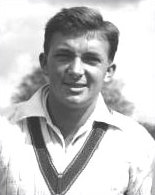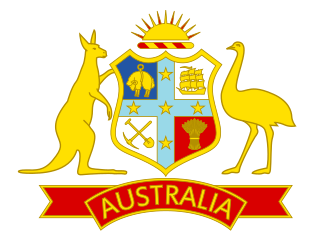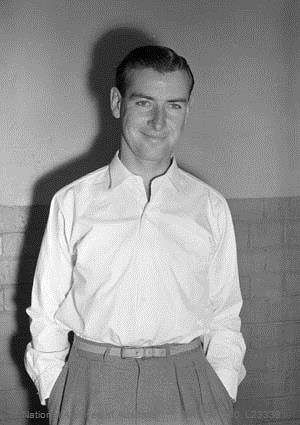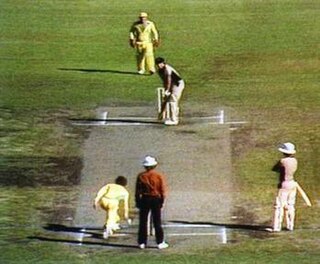Related Research Articles

Richard Benaud was an Australian cricketer who played for New South Wales and Australia. Following his retirement from international cricket in 1964, Benaud became a highly regarded commentator on the game.

Ian Michael Chappell is a former cricketer who played for South Australia and Australia. Known as "Chappelli", he is considered as one of the greatest captains the game has seen. He captained Australia between 1971 and 1975 before taking a central role in the breakaway World Series Cricket organisation. Born into a cricketing family—his grandfather and brother also captained Australia—Chappell made a hesitant start to international cricket playing as a right-hand middle-order batsman and spin bowler. He found his niche when promoted to bat at number three. Chappell's blunt verbal manner led to a series of confrontations with opposition players and cricket administrators; the issue of sledging first arose during his tenure as captain, and he was a driving force behind the professionalisation of Australian cricket in the 1970s. He was the captain of the Australian squad which finished as runners-up at the 1975 Cricket World Cup.

The Australia national cricket team represents Australia in men's international cricket. Along with England, it is the joint oldest team in Test cricket history, playing in the first ever Test match in 1877; the team also plays One-Day International (ODI) and Twenty20 International (T20I) cricket, participating in both the first ODI, against England in the 1970–71 season and the first T20I, against New Zealand in the 2004–05 season, winning both games. The team draws its players from teams playing in the Australian domestic competitions – the Sheffield Shield, the Australian domestic limited-overs cricket tournament and the Big Bash League. Australia are the current ICC World Test Championship and ICC Cricket World Cup champions. They are regarded as the most successful cricket team in the history of cricket.
Gregory Stephen Chappell is a former cricketer who represented Australia at international level in both Tests and One-Day Internationals (ODI). The second of three brothers to play Test cricket, Chappell was the pre-eminent Australian batsman of his time who allied elegant stroke making to fierce concentration. An exceptional all round player who bowled medium pace and, at his retirement, held the world record for the most catches in Test cricket, Chappell's career straddled two eras as the game moved toward a greater level of professionalism after the WSC schism. He was the vice captain of the Australian squad which finished as runners-up at the 1975 Cricket World Cup.
Trevor Martin Chappell is a former Australian cricketer, a member of the South Australian Chappell family which excelled at cricket. He played 3 tests and 20 One Day Internationals for Australia. He won the Sheffield Shield with New South Wales twice, and scored a century for Australia against India in the 1983 World Cup. His career was overshadowed, however, by an incident in 1981 in which he bowled an underarm delivery to New Zealand cricketer Brian McKechnie to prevent the batsman from hitting a six.

In cricket, the wicket-keeper is the player on the fielding side who stands behind the wicket or stumps being watchful of the batsman and ready to take a catch, stump the batsman out and run out a batsman when occasion arises. The wicket-keeper is the only member of the fielding side permitted to wear gloves and external leg guards. The role of the keeper is governed by Law 27 and of the Laws of Cricket.

A delivery or ball in cricket is a single action of bowling a cricket ball toward the batter. Once the ball has been delivered, batters may attempt to score runs, with the bowler and other fielders attempting to stop this by getting the batters out. When the ball becomes dead, the next delivery can begin.
Centenary Test refers to two matches of Test cricket played between the English cricket team and the Australian cricket team, the first in 1977 and the second in 1980. These matches were played to mark the 100th anniversaries of the first Test cricket matches played in Australia (1877) and in England (1880) respectively. Neither match was played for The Ashes.

Ian Meckiff is a former cricketer who represented Australia in 18 Test matches between 1957 and 1963. A left-arm fast bowler, he is best known for two matters that were unrelated to his skill as a player: he was the batsman run out by Joe Solomon in 1960, causing the first Tied Test in cricket history; and in December 1963, his career was sensationally ended when he was called for throwing in the First Test against South Africa by Australian umpire Col Egar. During the late 1950s and early 1960s, there had been a media frenzy about the perceived prevalence of illegal bowling actions in world cricket. The controversy and speculation that dogged Meckiff in the years preceding his final match caused sections of the cricket community to believe that he had been made a scapegoat by the Australian cricket authorities to prove their intent to stamp out throwing.
Bruce Adrian Edgar is a former cricketer who represented New Zealand in both Test and One Day International (ODI) format. A chartered accountant by profession, Edgar played as a left-handed opening batsman and an occasional wicketkeeper during one of New Zealand's most successful eras in international cricket. He gained respect across the cricket world for his courage against the fastest bowlers of his era, his classically straight batting technique, and his outstanding teamwork.

Martin Colin Snedden is a former New Zealand cricketer, who played 25 cricket tests, and 93 One Day Internationals, between 1980 and 1990. He was a member of New Zealand's seam bowling attack, alongside Richard Hadlee and Ewen Chatfield, throughout its golden age in the 1980s.
Alan Lloyd Thomson was an Australian cricketer, Australian rules football umpire and school teacher. Thomson, who "bowled off his front leg like a frog in a windmill" played in four Tests and one ODI in the 1970–71 season.
Peter Robert Enright, was an Australian cricket Test match umpire.
Peter Michael Cronin is a former Australian Test cricket match umpire, from South Australia.
Rex Vernon Whitehead was an Australian Test cricket match umpire, from Victoria.
The England cricket team toured Australia during the 1982–83 season, playing a five-Test series for The Ashes and a number of tour matches against Australian domestic teams before competing in a One-Day International (ODI) series against New Zealand for the Rothmans Cup. In between those competitions, England also participated in the Benson & Hedges World Series Cricket triangular ODI series against Australia and New Zealand.

The underarm bowling incident of 1981 is a sporting controversy that took place on 1 February 1981, when Australia played New Zealand in a One Day International cricket match, the third in the best-of-five final of the 1980–81 World Series Cup, at the Melbourne Cricket Ground.
The Indian cricket team began a tour of Australia in December 2007, playing the 4 match Test series for the Border–Gavaskar Trophy, followed by a single Twenty20 match on 1 February 2008. They also participated in the Commonwealth Bank tri-series against Australia and Sri Lanka from 3 February to 4 March.

The History of Australian cricket began over 210 years ago. The first recorded cricket match in Australia took place in Sydney in December 1803 and a report in the Sydney Gazette on 8 January 1804 suggested that cricket was already well established in the infant colony. By 1826, clubs including the Currency Cricket Club, the Military Cricket Club and the Australian Cricket Club had been formed. Hyde Park and the Racecourse were the venue for these organised matches. The formation of clubs in Van Diemen's Land was not far behind with clubs formed in Hobart in 1832 and Launceston (1841). In Western Australia a match was arranged in 1835 between the "builders" of the new Government House and a team of labourers and "mechanics". In Victoria in 1838, the Melbourne Cricket Club was formed – it would become arguably Australia's most exclusive and influential cricket club. In 1839, a club was formed in South Australia.

The 1970–71 Ashes series was the 45th edition of the long-standing cricket rivalry between England and Australia. Starting on 27 November 1970, the two sides ended up playing seven Tests; six were originally scheduled, but one extra Test was added to compensate for the abandoned Third Test.
References
- ↑ Wisden Cricketers Almanack – 119th edition (1982)
- ↑ Archived at Ghostarchive and the Wayback Machine : W T F Australia??? Why do they cheat at cricket? F*CK! Greg Chappell given not out- GREAT CATCH!. YouTube .
- ↑ Archived at Ghostarchive and the Wayback Machine : W T F Australia??? Why do they cheat at cricket? F*CK! Greg Chappell given not out- GREAT CATCH!. YouTube .
- ↑ The Underarm Ball That Changed Cricket, Abhishek Raghunath, Forbes India, 11 February 2011
- ↑ "Donald Weser profile and biography, stats, records, averages, photos and videos".